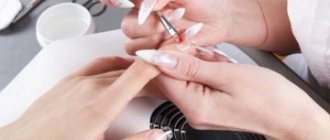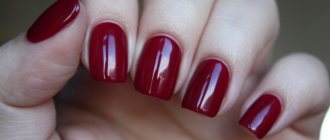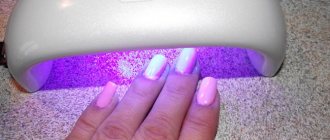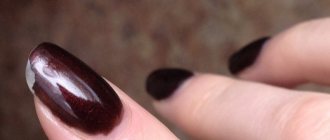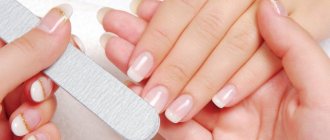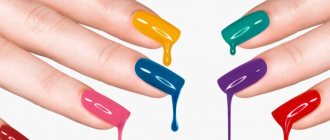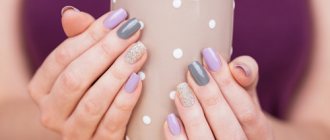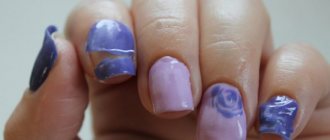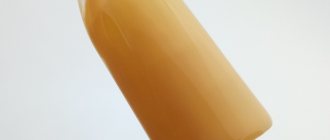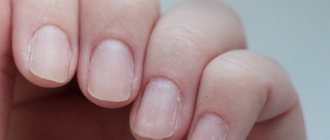It is difficult to imagine the life of a modern woman without nail care. For many, going to the master has become a monthly ritual. Today, clients prefer gel polish as the most practical and durable type of coating.
This product is a hybrid combination of gel and regular varnish. The owner of a gel manicure can enjoy neat and beautiful nails for at least two weeks. Unfortunately, sometimes women are disappointed and the manicure is not worn as expected. The coating chips off at the edges or peels off in whole pieces. Let's look at the reasons.
Why does the coating come off quickly and completely?
Detachment of the coating is associated with improper nail preparation and gel polish application technique. The main reasons why this happens:
- Improper processing of the natural nail plate is one of the most common culprits why gel polish peels off along with the base. It is important to completely remove the cuticle and sand the nail plate. Poorly removed gloss and dust residues interfere with the adhesion of the base coat and the nail. When sanding, the main thing is not to overdo it and not to grind down the nail plate too much. On a thin nail, the layer will adhere worse, and when drying in a lamp, painful sensations will occur.
- Insufficient degreasing or skipping this step is a typical mistake for beginners. The fat layer prevents the base from attaching well to the nail. It is necessary to wipe the plate with a napkin after grinding, paying special attention to the base of the nail and the area near the rollers.
- Use a primer or ultrabond to dehydrate. The gel does not apply well to nails that are not dry enough, so skipping this step is not recommended.
- It is very important to follow the application technique and monitor the thickness of the coating: too much material will not polymerize completely, and a thin layer will not provide the required strength. The gel should not get on the nail folds and cuticles.
- Anyone doing a manicure needs to monitor the condition of their lamp. If the radiation power is insufficient, the product will not polymerize. After some time, the coating will begin to swell, burst and peel off.
- The use of low-quality materials affects the final result.
If the master or you decide to save on the base, top and pigment, then there is nothing to be surprised about the short-lived manicure. It is advisable to use products from American manufacturers or other proven brands. It is also not recommended to combine materials from different companies, especially for beginners. As a rule, experienced craftsmen come to their favorite manufacturers and products through trial and error. - Many girls neglect manicure care. It is better not to come into contact with water for the first 2 hours after the procedure and not to test the strength of the manicure with excessive mechanical stress.
It is impossible to exclude the influence of individual characteristics of the body on the final result. Under their influence, the same manicure can be worn differently.
- Humidity has a negative impact on the durability of the coating, and some people suffer from overhydration.
- On a thin nail plate, the gel adheres worse, and the strength of the nail is less - there is a risk of breaking it. To avoid this, you need to strengthen the nail with gel.
- The presence of irregularities, tubercles, and cracks reduce the quality of adhesion between the coating and the nail. Before applying gel polish, you need to level the nail plate. Many masters do this with gel, simultaneously using it as a base coat.
- Taking antibiotics, antidepressants, diabetes, hormonal imbalances and even the phase of the female cycle can cause coating detachment.
https://youtu.be/https://www.youtube.com/watch?v=ujB_7VNHnqI
_
Behavior rules
We have already reminded you of how important it is to take care of gel polish coating. We propose to dwell on this in more detail. Forewarned is forearmed!
- Safety gloves should be your best friend when performing any work that involves handling hands.
- Ideal if you can protect your manicure from chemical and temperature effects. Even the highest quality and wear-resistant gel polish will surrender to such enemies.
- It is better to postpone a visit to the bathhouse, sauna and even the bathroom until the first 12 hours after the manicure. In general, the less water exposure at this time, the better.
- It is also better not to touch the finished coating at first. Contemplate the beauty, rather than stroking and rubbing your nails.
- In the cold, don't forget about mittens or gloves. This will protect not only your nails, but also your hands from harsh temperatures.
https://youtu.be/https://www.youtube.com/watch?v=D9ugtQYX6XA
_
We hope you have found out the individual reason why gel polish does not stay on your nails. It doesn’t matter whether your own body failed you or whether you found the root of the problem in the work of a master. Any of the listed reasons can be corrected, which means a gel polish manicure will delight you with its beauty and durability.
Reasons for chipping of gel-based coating on the tips
The causes of chipped ends most often lie in poor technique and improper care:
- The layer is not sealed at the end. Some masters are guilty of this, especially when they work with short lengths. If you don't paint the end, the coating will probably start to chip.
- Sometimes clients apply the layer themselves when they adjust their clothes, pick up the phone, or put their hand under a lamp.
- Improper care after the procedure makes the manicure short-lived. It is better to avoid water for several hours before and after the procedure, but many girls neglect this.
- Gel polish is a fairly durable material, but it cannot withstand severe or frequent mechanical damage. Impacts or scratches damage the integrity of the coating.
- You cannot adjust the length or file the nail yourself, otherwise the coating may crack.
- Thin nails will probably break off under gel polish, thereby causing chips.
How to choose a master who will not let you down
If you suspect that the reason for the low durability of gel polish is the mistakes of the technician, then you need to urgently start looking for a real professional.
You shouldn’t blindly go to a person who receives you at home after seeing a tempting ad on social networks or at a bus stop.
Step number one is to study the work of the master and reviews of his clients. Ask your friends and acquaintances if they can recommend you a specialist whose quality of services they are 100% satisfied with.
If you don’t succeed in finding “your person” this way, continue your search in good beauty salons, which simply cannot risk their reputation and provide low-quality manicures.
Interesting : Learn how to apply gel polish at home
What to do to avoid detachment and chipping?
- Proper preparation. A few hours before a manicure, it is not recommended to soak your hands, take baths or do general cleaning. Contact with harsh chemicals is best avoided. In this case, it is recommended to use rubber gloves.
- Proper processing. To treat the nail plate and cuticle, it is better to choose a method without soaking. A classic edged manicure can be done in advance so that your hands dry well, but not before applying the coating. The most successful method is hardware (using a cutter). For sensitive and thin skin, choose a European manicure. Using an orange stick, carefully move the peel from the work surface to the edge. It is important to completely remove the cuticle and pterygium: ignoring the skin film on the nails affects the quality of the coating. Be careful not to damage the skin of your finger. Blood or bruises will interfere with the proper application of gel polish.
- Grinding .
For adhesion, you need to sand the nail well. This needs to be done with a special buff. It is extremely important to treat the entire surface of the nail, especially around the cuticle and nail folds. If it is difficult to get there with a buff, use a nail file. Do this very carefully: the highly abrasive buffer and file will severely scratch the skin. It would be correct to focus on your own feelings if you are doing a manicure for yourself, or the client’s reaction if you are doing the work as a master. Don't overdo it and don't scratch the plate. - Degreasing and dehydration . Do not neglect this stage - the fatty film prevents the layer from fixing. The degreasing agent is applied with a napkin to the polished nail. Work diligently on the side rollers and base. After using the degreaser, do not touch the plate with your fingers, so as not to stain it with sebum, dust, lint or other debris. The nail is dehydrated with a special product - primer or ultrabond. Even if your hands are dry and have not been in contact with water for the last few hours, do this to be on the safe side. If your hands suffer from sweating, you can apply the product in two layers.
- Application technique . The base should be applied in an even layer; it should not get on the cuticle or bleed. When this happens, you need to correct the mistake by removing the leaky gel polish with an orange stick. If you send such work into a lamp, then over time the coating will begin to move away from the skin and delaminate. Air and water will get into the resulting voids, and the manicure will peel off. Each layer must be applied fairly quickly so that they do not spread. It is important not to overdo it with thickness, but it is pointless to play it safe with a thin layer - such a nail will quickly bend or break off. It is very important to seal each layer at the end, then the manicure will last longer.
- Aftercare .
After the procedure, it is not advisable to come into contact with water for the first 2 hours. On this day, avoid taking hot baths and spa treatments. Complete polymerization of the layers is completed after 12 hours. In the future, there are no strict prohibitions or restrictions on contact with water, although keeping your hands unprotected for a long time in a damp or aggressive environment can shorten the life of your manicure. If you start working in the garden or general cleaning, use rubber gloves for safety. Do not listen to the masters who are guilty of long bath procedures. They are either playing it safe or trying to justify their poor quality work. Mechanical damage and impacts can cause damage to the gel coating. Try to be careful when handling sharp objects, moving heavy objects, or playing sports. An unsuccessful finger strike - and hello, a broken nail. If a chip occurs, do not be lazy to redo the work. When filing without subsequent fastening, the layer may crack. If you can’t fix the damage yourself or have a professional fix it, and a jagged nail interferes with your life, you need to trim it yourself with a nail file and cover it with regular clear varnish. - Quality materials.
- Use trusted manufacturers, do not buy cheap coatings made in China. You should not buy 3in1 or 2in1 products. Use products for gradual application.
- Follow expiration dates and storage rules. Jars with base, pigment and top should be kept in a dry, dark place.
- Keep an eye on the condition of your consumables: worn-out files can leave jagged edges on the end of the nail, and buffs become covered with a layer of grease over time from handling and sanding.
- The LED lamp must be powerful enough for the coating to fully cure. Regularly check the condition of the LEDs, change them if the lamp design allows it, or purchase a new one. The lamp is replaced every 3–6 months depending on the intensity of use.
- The cutter attachments need to be changed every 2-3 months. The machine itself tends to become loose, which causes strong vibration during use.
strongly recommended that you be wary of unknown manufacturers of coatings and treatments . Their use can be not only ineffective, but also harmful to health. There is a risk of getting chemical burns, damaging the nail plate or causing allergic reactions.
Precautionary measures, the use of high-quality materials and equipment, and adherence to technology will help make your manicure not only beautiful, but also durable.
Shelf life of regular varnish
This question is not as straightforward as it seems. This is due not only to the quality of the product, but also to the condition of the plate:
You must wear gloves when doing homework. This is especially true for wet cleaning and dishwashing. Such safety measures extend the “life” of the manicure. Usually the varnish holds up for those who take care of their hands and fulfill this simple requirement.
Poor quality of the nail plate
What do numerous reviews say about all this? Why doesn't shellac stick to nails? Comments do not always contain information about the initial state of the nail plates. But sometimes the coating does not last because the quality of the nails themselves is very poor. For example, if they are peeling or covered with grooves from improper technique of the previous manicure, you must first straighten the nail plate.
If the master does not do this, the shellac will begin to come off within a couple of days after coating. Therefore, if a specialist offers to include this service in the cost of a manicure, you cannot refuse it. Especially if the nail problem is visible to the naked eye.
Poor sealing of nail edges
When covering the nail plate with a base, a colored layer, and then a top, each stage should end with sealing the free edge of the nail. This must be done in the thinnest layer so that the nails look neat. This nuance will significantly strengthen the coating and prevent chipping of the ends.
You may be interested in: How to remove shellac in a salon: all methods and options, the safest method
When masters neglect this nuance, shellac comes off from the edges of the nails. After this, dissatisfied clients find a reason why shellac does not stick to their nails. “I use proven products, I don’t know what happened” - you can often hear from craftsmen who did not process the edges. But if this happens, you should demand that the poor-quality work be redone.
If this is not done, air, as well as dirt and moisture, will begin to get under the nail plate. If you pry the edge of the coating, you can remove it with film. Of course, this should never be done. If such a problem occurs, you need to make an appointment at the salon as soon as possible to remove the low-quality coating.
Gel extensions - what kind of procedure is it?
Gel is a plastic material that is easy to work with. It allows you to do nail extensions both at home and in a beauty salon. As a result of the master’s work, the length of the nails increases, their shape changes, and the surface is smoothed.
Gel nail extensions
Gel extensions last up to 4 weeks ; the structure of this polymer resembles natural nails , and it looks much more natural than acrylic.
There are two methods of extension using gel. The first is a sticker of ready-made artificial plates (tips), and the second is an extension in shape.
This method requires durable stencils that are applied to the nails, and the gel is applied through the “window”. After the gel has completely hardened, the forms are removed, and the result is beautiful nails with a length longer than natural.
